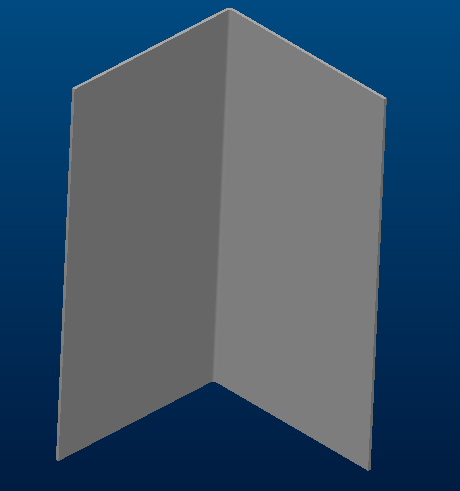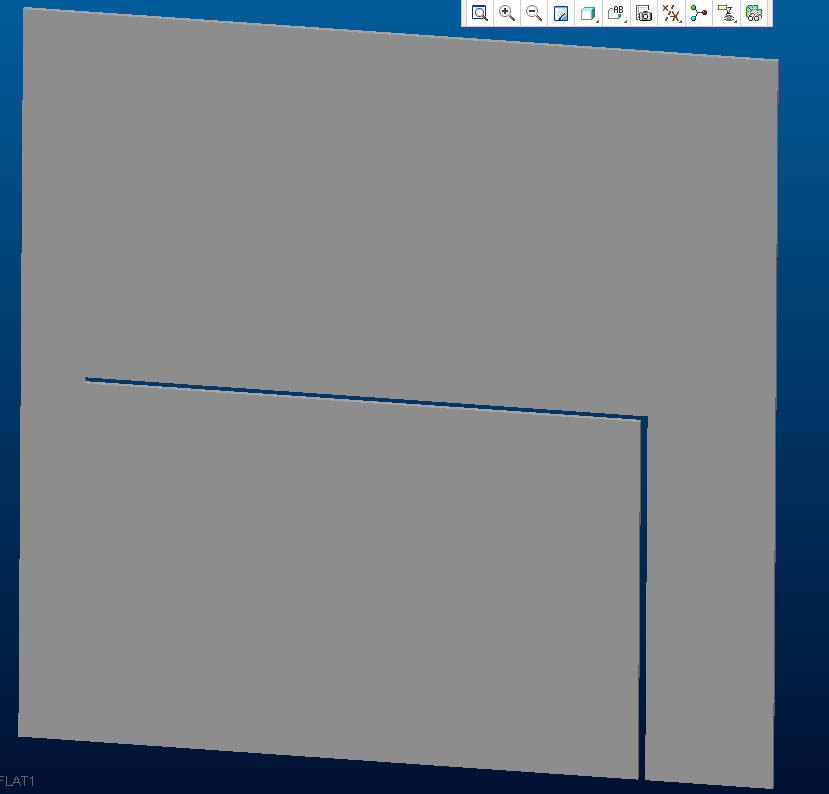Community Tip - Need to share some code when posting a question or reply? Make sure to use the "Insert code sample" menu option. Learn more! X
- Community
- Creo+ and Creo Parametric
- 3D Part & Assembly Design
- Sheet metal opposing bends feature creation
- Subscribe to RSS Feed
- Mark Topic as New
- Mark Topic as Read
- Float this Topic for Current User
- Bookmark
- Subscribe
- Mute
- Printer Friendly Page
Sheet metal opposing bends feature creation
- Mark as New
- Bookmark
- Subscribe
- Mute
- Subscribe to RSS Feed
- Permalink
- Notify Moderator
Sheet metal opposing bends feature creation
Hi
I've created a sheet metal feature which has bends going in opposing directions from each other, see the attached image. The feature is essentially a rip across a bend with the corners of each bend folding at 90 degrees in opposite directions. When I try to flatten this part it gives an error.
I have tried creating this in two ways:
- By adding a flange and then joining the open end using the join tool.
- Making a form tool and punching the one shape into the other.
Both methods worked to create the feature but neither method works when I try to flatten the part.
What would be the best way to create this feature in order to create a flattened state?
Regards
David
- Labels:
-
General
- Mark as New
- Bookmark
- Subscribe
- Mute
- Subscribe to RSS Feed
- Permalink
- Notify Moderator
Try adding bends on the inward facing portion where it is pulled from the larger outward bend. I only see 2 bends and you need 4.
- Mark as New
- Bookmark
- Subscribe
- Mute
- Subscribe to RSS Feed
- Permalink
- Notify Moderator
There are actually 4 bends but I was using a zero internal bend radius. See the below image with internal bend radii added. Still the same problem. It seems as though Creo needs to have one end of the flange open in order to allow a flattened state.
Any ideas?

- Mark as New
- Bookmark
- Subscribe
- Mute
- Subscribe to RSS Feed
- Permalink
- Notify Moderator
You can't get a flat pattern from your part because Creo isn't able to model the deformation you are imagining. The developed length of the inward bent section does not match the developed length of the outside corner section. You can see that if you add a sketched rip, for example, on one of the inward-facing walls - then you'll get your flat pattern. There will be a gap in it that "butts-up" when the part is "folded". You can affect the size of this gap - even get the flat pattern to overlap itself there - by changing the various bend radii in the part. But all this is subject to the assumptions about deformations and bend allowances and might not be at all how the reality (un)folds...
- Mark as New
- Bookmark
- Subscribe
- Mute
- Subscribe to RSS Feed
- Permalink
- Notify Moderator
This part can't be made with a bending operation - it requires die-forming. I expect there is a way to create a die-form feature that produces the inner bend, which will flatten.
Paul Sobejko's suggestion is correct and to work through the reason - each bend in sheet-metal stretches the metal; in the primary corner this happens once; in the formed section this happens three times, so Creo would have to remove two extra bend allowances to make the part flat. That's what forms the gap is a rip is added, the subtraction of the extra bend allowances.
In addition, Creo needs to be able to unfold the part one bend at a time; this part requires 4 bends to unfold simultaneously. Unfolding only one bend line at a time is a reasonable assumption in Creo because bending equipment (not forming) only needs to perform one bend at a time.
- Mark as New
- Bookmark
- Subscribe
- Mute
- Subscribe to RSS Feed
- Permalink
- Notify Moderator
Hi Paul and dschenken
Thank you both for your explanations, I understand the reasoning here. However, it is possible in reality to make this part using die-forming and Creo has die-forming/punching operations. I'm surprised that Creo cannot calculate this irrespective of the bend allowance since it calculates the stretching of metal in other die forming features.
I've tried to create the shape by starting with a flat peice of sheetmetal and punching the shape out and though I did manage to get the final form, it didn't distort the material in a realistic manner and it wouldn't flatten again using either the flatten form or the flat pattern functions so it would be hard to know what the correct flat pattern should be at the outset.
Further to this, if this shape were part of a larger sheet metal part with other features around it (which it is) then it's difficult to know what design intent to use to get the part from its designed shape to a realistic flat pattern to send for manufacturing.
Thanks again for the explanations but this one has me stumped!
- Mark as New
- Bookmark
- Subscribe
- Mute
- Subscribe to RSS Feed
- Permalink
- Notify Moderator
I believe you overestimate the extent of modeling that Creo does when it comes to sheetmetal die forming/punching operations.
I don't think there are any stretching calculations actually being done and only a "visual" representation is produced.
- Mark as New
- Bookmark
- Subscribe
- Mute
- Subscribe to RSS Feed
- Permalink
- Notify Moderator
Creo doesn't calculate anything about die-forming operations. It merely ignores the feature when it does the flat pattern.
If you were to create a die form shaped like a toad-stool, Creo would probably 'flatten' it.
The problem with such shapes is there is no correspondence between the flat form and the final form because the deformation of the metal depends on the forming process, not the start shape and end shape.
To do better requires an incremental FEA solution that includes calculating the inverse of the forming operation, such as contact loads, and friction. Not an easy thing. There is some software that handles the forward solution, starting with a flat pattern and simulating a forming operation and can include material thickness and cold-work hardening effects.
- Mark as New
- Bookmark
- Subscribe
- Mute
- Subscribe to RSS Feed
- Permalink
- Notify Moderator
I have made the part with following features:
- extrude (wall)

- extrude (cut)

- flange (wall) which is attached to both edges - this wall is sketched with radii, no bend reliefs. The image next to it is the flat instance - for whatever reason it is not attached on one side, but it is attached in unflatten state. Not sure if this will help you any.


- Mark as New
- Bookmark
- Subscribe
- Mute
- Subscribe to RSS Feed
- Permalink
- Notify Moderator
Thanks for all the replies.
What I have ended up doing is similar to the above solution but I managed to get the flange to line-up in the flattened state by playing with the flange settings. I think this will work for now since it looks right in the folded state and flattened state when taken into a drawing, though it is a bit of a "cheat" method.![]()
Thanks again all.
- Mark as New
- Bookmark
- Subscribe
- Mute
- Subscribe to RSS Feed
- Permalink
- Notify Moderator
Hi,
I have created a sheet metal, it only shows bend down on both sides of sheet metal.
Kindly suggest me to change to bend up.
Thanks in advance,
Hari Prasanth
- Mark as New
- Bookmark
- Subscribe
- Mute
- Subscribe to RSS Feed
- Permalink
- Notify Moderator
It sounds like you'll need to change your Driving Surface of your sheetmetal part.
- Mark as New
- Bookmark
- Subscribe
- Mute
- Subscribe to RSS Feed
- Permalink
- Notify Moderator
I tried by changing the driving surface but it shows the same bend down.
Thanks,
Hari Prasanth





